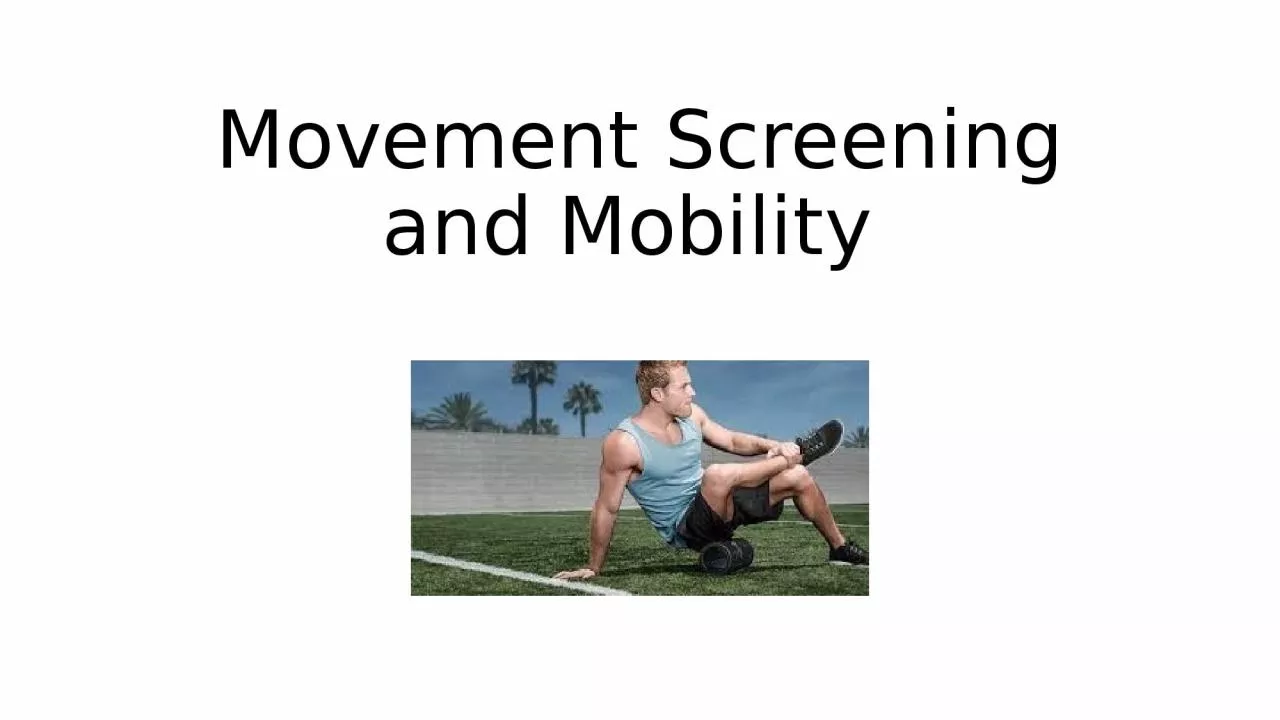

Why do we Screen movement The significant rate of injury development in individuals starting exercise That exercise drop out is high in exercise beginners Fear of injury and actual injury are often reported as a reason for non participation Finch 2008 ID: 1030448
Download Presentation The PPT/PDF document "Movement Screening and Mobility" is the property of its rightful owner. Permission is granted to download and print the materials on this web site for personal, non-commercial use only, and to display it on your personal computer provided you do not modify the materials and that you retain all copyright notices contained in the materials. By downloading content from our website, you accept the terms of this agreement.
1. Movement Screening and Mobility
2. Why do we Screen movement? The significant rate of injury development in individuals starting exercise That exercise drop out is high in exercise beginners Fear of injury and actual injury are often reported as a reason for non participation (Finch 2008)
3. Which treatment methods do we use? Stretching vs Foam Rolling ? Proprioceptive Neuromuscular Facilitation stretching ?Trigger Point Release ?
4. First we need to know why our client is tight ?COMMON CAUSES OF TIGHTNESS Joint constraints, potentially from bone structure, joint capsule and ligamentous structure Subcutaenous connective tissue (fascia) and skin Neurogenic constraints such as voluntary and reflexive control over stretching muscle Myogenic constraints, meaning the passive and active resistive properties of muscle fibres Do they have a sedentary lifestyle leading to local tissue dehydration ? Are they well hydrated throughout the day?
5. The Back Squat Strengthens the prime movers used in athletic movements Strengthens extensor chain musculature Is a functional based movement that mimics day to day activities
6. The Back Squat Assessment Neutral lumbar position, No hyperextension or flexion Trunk Parallel to shins Thighs reach Horizontal plane Dowel over footprint Vertical pelvic displacement Knees in line with feet
7. Trunk not parallel with shins Secondary Assessment Ankle Knee to wall If less then 10 – 12cm Foam Roller Tibials anterior / Retinaculum/ Calves Pendulums + Band flossing PNF Calves
8. Pelvis not moving vertically (alignment in coronal plane)Secondary Assessment Supine passive hip internal rotation If less then 45 degrees Band hip flossing Foam roll pubic Symphisis
9. Knees not tracking over feet Supine Passive hip External rotationIf less then 10 degrees Foam Roll Glutes PNF stretch glutes / Hamstrings Hamstring Theraband flossing
10. Thighs not to horizontal Secondary Assessment Thomas Test Foam roll flexors PNF Thomas test stretch
11. Thoracic Rotation Adequate thoracic mobility is required so that extension of the lumbar spine is not required Can they achieve approximately 45 degrees with no compensatory patterns? Performs worse with hands behind head? > Release TFL / Pec
12. Overhead Reach Neutral plumb not maintained > Thomas test > PNF hip flexors > Foam roller anterior hip Arms moving forward from frontal plane > Passive GHJ ROM > PNF rotator cuff > pec minor PNF
13. Other movement screening test Active Straight leg raise Deadlift with Bent over Row 4 point kneel with leg and arm extension Push up from ground Lunge Single leg Squat
14. A study conducted in South Australia found that 38% of sedentary people who started a new exercise program reported new musculoskeletal injuries. The study emphasised the vulnerability of previously sedentary persons beginning a new exercise program to new musculoskeletal injuries. Another study showed as many as 20% of survey respondents representative of an Australian urban population gave current injury or disability as a reason for not being more active and 40% of 40 – 60 year olds stated that fear of injury as a reason for why they didn’t exercise. This highlights our responsibility as practitioners to pick up on these issues and give confidence to the client that you are treating. RESEARCH
15. RESEARCH Stretching A systematic review (Shrier 2004) showed either no, or detrimental effect upon; isometric force, isokinetic torque and jumping height A Systematic review (Anderson 2005) showed that both pre and post stretching is ineffective in reducing DOMS A systematic review (Weldon & Smith 2003) found that pre exercise stretching was ineffective for reducing injury riskA systematic review by Harvey, Herbet and Crosbie (2002) found muscles that tested relatively tighter showed the greatest improvements in ROM and that the stretching intervention needs to be 3 weeks or greater before long term changes were observed.
16. RESEARCH Foam Rolling (Peacock et al 2014) found that foam rolling was able to improve measures of power such as vertical jump, horizontal jump and sprinting. (Macdonald et al 2013 and Sullivan et al 2013) found that short bouts of foam rolling were effective in improving range of motion in the quadriceps (10 degrees) and sit and reach test (4.3%) with no subsequent loss of performance Halperin et al (2014) investigated the effects of foam rolling of the plantar flexors on ankle dorsiflexion ROM and found that it was successful in improving ROM to the same extent as static stretching. (Macdonald et al 2014) found that 20 minutes of foam rolling after an intense lower body workout decreased post exercise soreness relative to controls across all time points, as well as allowing greater vertical jump height.